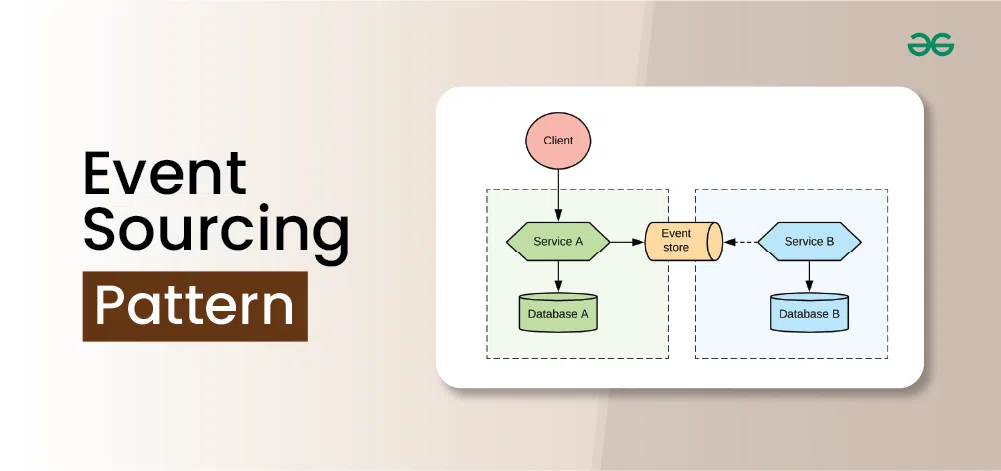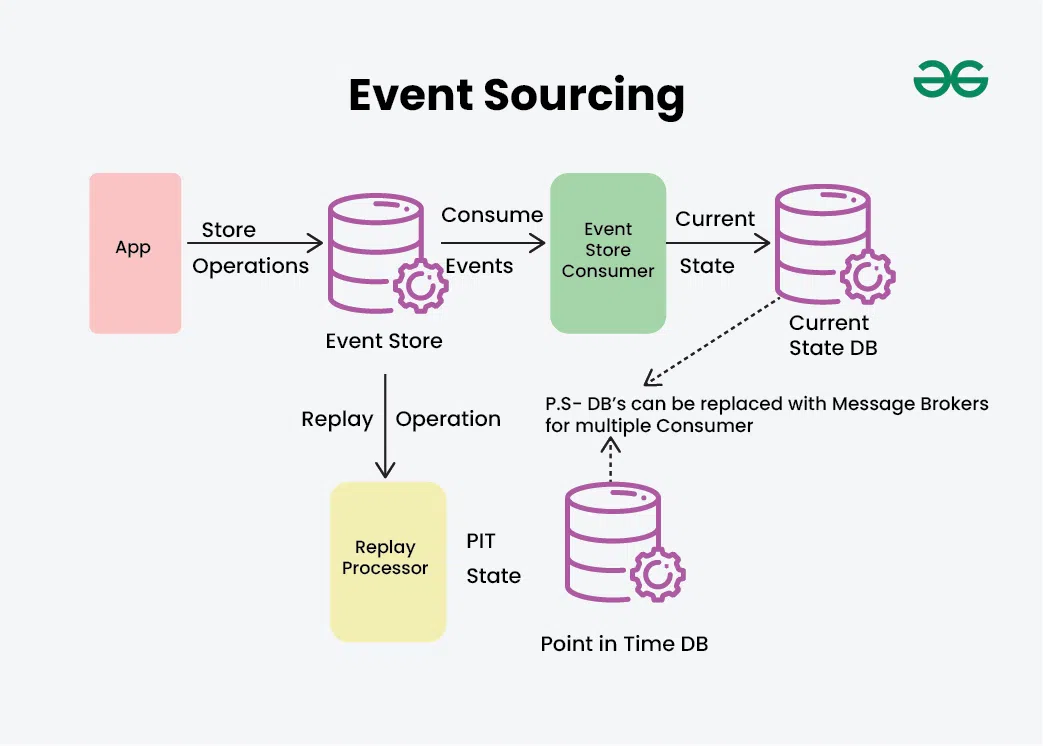|
The Event Sourcing Pattern is like keeping a detailed diary for your software. Instead of just updating the current state of your data, you record every change as a separate event. These events form a complete history of what happened to your data over time. So, if you want to know how your data got to its current state, you can replay these events to reconstruct it. This pattern is useful for auditing, debugging, and even predicting future trends based on past actions.

Important Topics for Event Sourcing Pattern
What is Event Sourcing?
Event Sourcing is a design pattern used in system architecture where the state of an application is determined by a sequence of events. Instead of directly modifying the state of an object or database, changes to the application’s state are captured as a series of immutable events.
- These events are stored sequentially, forming a log or journal of actions that have occurred.
- By replaying these events, the application’s state can be reconstructed at any point in time.
- Event Sourcing offers benefits such as auditability, scalability, and the ability to derive new insights from historical data.
- It’s commonly used in domains where accurate historical records are crucial, such as finance or e-commerce.

Core Concepts and Components of Event Sourcing
Event Sourcing in system design revolves around several core concepts and components:
- Events: These are immutable records of state changes within the system. Each event represents a specific action or occurrence and contains all the relevant information needed to reconstruct the state of the system at the time the event occurred.
- Event Store: The event store is a durable data store that continues the stream of events generated by the system. It stores events in the order they were received, ensuring that the sequence of events is preserved. The event store typically supports operations such as adding new events and querying events based on various criteria.
- Aggregate: An aggregate is a logical grouping of related domain objects that are treated as a single unit for the purpose of processing commands and generating events. Aggregates encapsulate the business logic and state changes within the system. Each aggregate is associated with its own stream of events in the event store.
- Command: Commands are requests or instructions issued by clients or other parts of the system to perform specific actions. Commands are processed by aggregates, which validate the command, apply business logic, and generate corresponding events if the command is accepted.
- Projection: Projections are read models that represent the current state of the system derived from the stream of events stored in the event store. Projections are typically optimized for querying and are used to provide efficient access to data for querying and reporting purposes.
- Event Bus: An event bus is a messaging infrastructure that facilitates the communication of events between different parts of the system. It allows components to subscribe to specific types of events and react to them asynchronously.
Benefits of Event Sourcing
Event Sourcing offers several benefits in system design:
- Precise Record of Events: Event Sourcing keeps track of every change in a system, creating a detailed and unchangeable history of all actions. This record is super helpful for following rules, fixing problems, and investigating issues.
- Temporal Querying: With event sourcing, you can replay events up to a given point in time to query the system’s current state. This temporal querying capability enables historical analysis, trend prediction, and debugging of past issues.
- Flexibility and Evolution: Event Sourcing promotes flexibility and evolution of the system over time. Since events represent facts about what happened, new types of events can be added to accommodate changes in business requirements without affecting existing components.
- Parallel Processing: Events are appendonly and can be processed in parallel, making Event Sourcing well-suited for distributed systems and scaling horizontally. Different components can independently consume and process events, improving performance and scalability.
- Replayability for Testing: Events can be replayed to recreate specific scenarios for testing and validation purposes. This enables thorough testing of system behavior under various conditions, including edge cases and rare events.
- Event-Driven Architecture: Event Sourcing naturally aligns with event-driven architecture paradigms, facilitating loose coupling and asynchronous communication between system components. This can lead to better scalability, maintainability, and responsiveness.
Challenges of Event Sourcing
While Event Sourcing offers various benefits, it also presents several challenges:
- Complexity: Event Sourcing introduces additional complexity compared to traditional CRUD-based architectures. Managing event streams, ensuring consistency, and implementing event-driven workflows require careful design and development.
- Event Versioning: As the system evolves, the structure of events may change. Handling event versioning and backward compatibility becomes crucial to ensure smooth upgrades and migrations without losing historical data or disrupting existing functionality.
- Event Storage and Retrieval: Storing and retrieving large volumes of events efficiently can be challenging, especially in scenarios with high throughput or long event histories. Implementing optimized event storage solutions and querying mechanisms becomes essential.
- Eventual Consistency: Event Sourcing typically results in eventual consistency, where different parts of the system may observe state changes at different times. Dealing with eventual consistency requires careful consideration of data synchronization, conflict resolution, and handling of stale data.
- Debugging and Troubleshooting: Debugging and troubleshooting in Event Sourcing systems can be more complex due to the distributed nature of event processing and the asynchronous nature of event-driven communication. Tools and techniques for tracing events, replaying scenarios, and monitoring system behavior become crucial.
- Performance Overhead: Event Sourcing may introduce performance overhead compared to CRUD-based approaches, especially in scenarios with frequent state reconstruction or complex event processing logic. Optimizing event processing pipelines and balancing trade-offs between consistency and performance is necessary.
Use Cases and Applications of Event Sourcing
Event Sourcing finds applications in diverse domains and use cases where tracking and analyzing historical data is crucial. Here are some notable examples:
- Financial Systems:
- Banking and financial institutions utilize Event Sourcing to maintain an immutable record of transactions, account activities, and compliance events. This approach ensures accurate auditing, fraud detection, and regulatory reporting.
- Healthcare Records:
- Electronic health record (EHR) systems leverage Event Sourcing to capture patient interactions, medical procedures, and treatment histories. By maintaining a detailed event log, healthcare providers can improve patient care, streamline workflows, and comply with regulatory standards.
- Supply Chain Management:
- Event Sourcing is employed in supply chain and logistics management to track inventory movements, shipping updates, and supply chain disruptions. It facilitates real-time visibility into the supply chain, enhances inventory management, and enables proactive decision-making.
- E-commerce Platforms:
- Event Sourcing is valuable for e-commerce applications to record customer interactions, order fulfillment processes, and inventory changes. This enables personalized recommendations, order tracking, and analysis of customer behavior to improve sales and customer satisfaction.
- Gaming and Virtual Environments:
- Multiplayer online games and virtual environments utilize Event Sourcing to capture player actions, game state changes, and in-game transactions. It supports features like replay functionality, cheat detection, and dynamic world generation based on player interactions.
- Social Media Analytics:
- Social media platforms leverage Event Sourcing to capture user engagement metrics, content interactions, and advertising campaigns. By analyzing historical events, organizations can optimize content delivery, target advertisements, and measure campaign effectiveness.
Real-World Example
A real-world example of Event Sourcing can be seen in a modern banking system.
Let’s consider a scenario where a bank wants to implement Event Sourcing for its account management system.
- Account Operations: Whenever a customer performs an action that affects their account, such as depositing money, withdrawing funds, transferring money to another account, or updating personal information, the system generates corresponding events.
- Event Logging: These events are logged into an event store in the order they occur. Each event contains relevant information such as the type of operation, the amount involved, timestamps, and any other metadata necessary to reconstruct the state of the account.
- Event Processing: Event handlers or processors consume these events and update the state of the affected accounts accordingly. For example, if a “Deposit” event is recorded, the account balance is incremented. If a “Withdrawal” event is logged, the balance is decremented.
- Auditability: The event store serves as a complete audit trail of all account transactions and changes over time. Bank administrators or auditors can query the event store to retrieve specific transactions, verify account balances, or investigate any discrepancies.
- Replayability: In case of disputes or disagreement, the bank can replay the sequence of events leading to a particular account state to investigate what happened. This replayability ensures transparency and accountability in the banking system.
- Scalability and Resilience: Event Sourcing allows the bank’s system to scale horizontally by distributing event processing across multiple nodes. In case of failures or downtime, the system can recover by replaying events from the event store to restore the state of accounts.
- Regulatory Compliance: Event Sourcing helps the bank comply with regulatory requirements by maintaining a complete and immutable record of all account activities. This ensures that the bank can demonstrate compliance with laws and regulations governing financial transactions.
By implementing Event Sourcing in its account management system, the bank gains benefits such as improved auditability, scalability, resilience, and regulatory compliance. It also provides a transparent and accountable mechanism for tracking account transactions and resolving disputes.
Conclusion
In conclusion, Event Sourcing is like keeping a detailed diary for your software. By recording every change as a separate event, it provides an accurate and immutable record of all actions taken within a system. This pattern offers benefits such as improved auditability, scalability, and resilience. It enables accurate historical analysis, real-time tracking of system state, and efficient troubleshooting.
|


